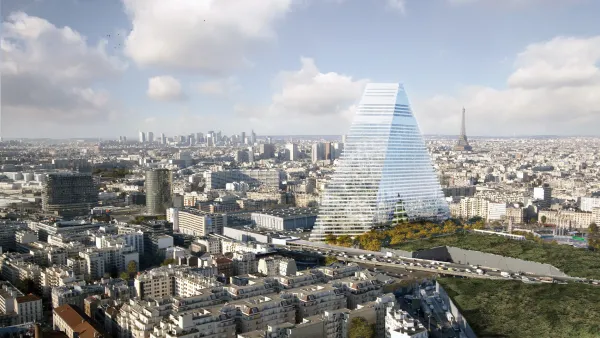Drawing inspiration from Paris and Barcelona, Kaid Benfield offers his take on the recent controversy surrounding height limits in the nation's capital, enumerated point-by-point against arguments over capacity, density, affordability, and beyond.
Established over a century ago, height limits on development in Washington, D.C. have recently come under fire by not a few prominent pundits, from Ed Glaeser to Matt Yglesias to Ryan Avent. But longtime D.C. resident and National Resources Defense Council blogger Kaid Benfield is skeptical of the criticisms leveled against existing laws, arguing (among other things) that the absence of skyscrapers lends D.C. an aesthetic sensibility otherwise seen only in European cities like Paris or Barcelona.
"Paris is more like Washington," writes Benfield. "One of the world’s most beautiful and beloved cities, the French capital has generally restricted building heights in the city center in relation to the streets the structures border, with a maximum height of 121 feet for new structures. As a result, when one stands on top of the hill in Montmartre, the vista reveals a mid-rise central city, with buildings of six or seven stories."
But his position extends beyond the visual character of the city. Benfield offers the following responses to the most common criticisms of existing heigh limits:
- D.C. is running out of room.
"In 1950, with the height restrictions fully in effect, the city’s population was 802,178. In 2011, its estimated population was 617,996. The truth is that we were a “shrinking city” until about a decade ago, and we are nowhere near full capacity today."
- Height limits inflate the cost of housing.
"If affordability were closely related to building height and density, New York City and San Francisco would be the two most affordable big cities in America."
- Density makes for a better urban environment.
"The key is to increase average density all across a metro area so that the region’s footprint doesn’t expand; parts of the region that are already relatively dense, such as downtown Washington, are fine as they are."
- Height limits are an obstacle to good architecture.
"Maybe it’s a matter of taste, but to my eyes the unrestricted high-rise architecture of the denser suburban centers near our area’s Metro stations – probably a decent approximation of what we might get downtown without the height limit – is worse, ranging from boring to awful."
For Benfield, it boils down to an if-it-ain't-broke-don't-fix-it scenario: "Why the heck change, especially when... DC’s mid-rise cityscape is one of its distinguishing, much-loved assets? Tinkering with a successful status quo is a solution in search of a problem."
FULL STORY: Why I support the DC building height restrictions

Analysis: Cybertruck Fatality Rate Far Exceeds That of Ford Pinto
The Tesla Cybertruck was recalled seven times last year.

National Parks Layoffs Will Cause Communities to Lose Billions
Thousands of essential park workers were laid off this week, just before the busy spring break season.

Retro-silient?: America’s First “Eco-burb,” The Woodlands Turns 50
A master-planned community north of Houston offers lessons on green infrastructure and resilient design, but falls short of its founder’s lofty affordability and walkability goals.

Test News Post 1
This is a summary

Analysis: Cybertruck Fatality Rate Far Exceeds That of Ford Pinto
The Tesla Cybertruck was recalled seven times last year.

Test News Headline 46
Test for the image on the front page.
Urban Design for Planners 1: Software Tools
This six-course series explores essential urban design concepts using open source software and equips planners with the tools they need to participate fully in the urban design process.
Planning for Universal Design
Learn the tools for implementing Universal Design in planning regulations.
EMC Planning Group, Inc.
Planetizen
Planetizen
Mpact (formerly Rail~Volution)
Great Falls Development Authority, Inc.
HUDs Office of Policy Development and Research
NYU Wagner Graduate School of Public Service



























